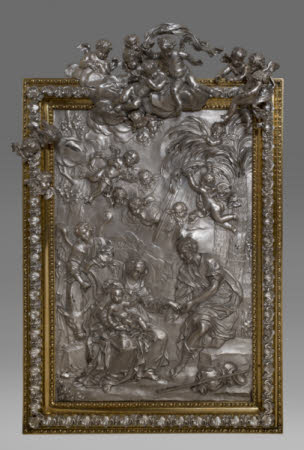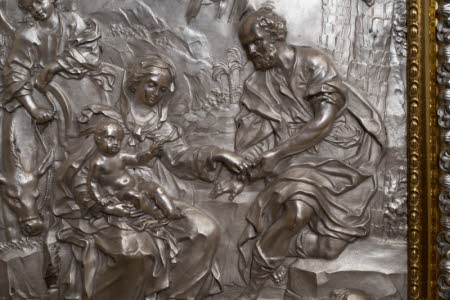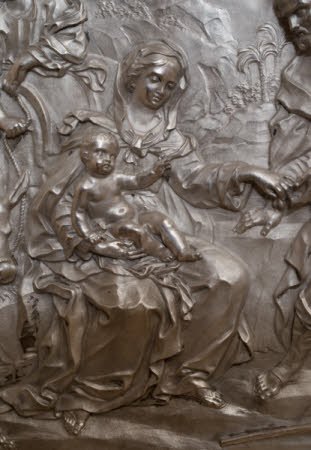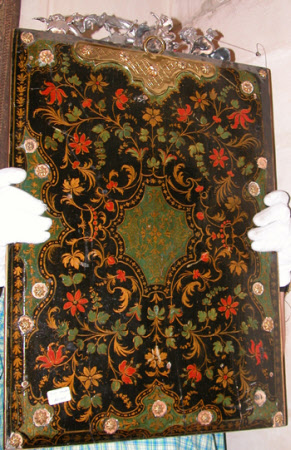Rest on the Flight into Egypt
Francesco Natale Juvarra (1673 - 1759)
Category
Art / Sculpture
Date
c. 1730 - 1758
Materials
Silver, gilt bronze, wood, paint
Measurements
786 mm (Height)
Place of origin
Rome
Order this imageCollection
Anglesey Abbey, Cambridgeshire
NT 516398
Summary
Silver, Rest on the Flight into Egypt, Francesco Natale Juvarra (1673-1759), c. 1730-58. A silver relief depicting the Rest on the Flight into Egypt, with the Holy Family in a landscape, behind them their donkey, held by an angel, more angels in the sky. Within an elaborate silver and gilt-bronze frame, the back made of painted wood. A masterpiece of Roman silver sculpture, by the Sicilian-born goldsmith Francesco Natale Juvarra (1673-1759).
Full description
A large embossed and chased silver relief depicting the Rest on the Flight into Egypt, with the Holy Family seated within a landscape, with rocky hills in the distance. At the right two date palm trees. Mary is seated on a rocky bank, with the Christ Child on her lap, whilst Joseph half-kneels on the bank. Mary takes a date offered to her by Joseph and which Christ blesses. At bottom right Joseph’s staff and travelling bundle. To the left, an angel tends the donkey. In the upper half of the relief, a mixture of winged putti and winged seraphim and cherubim heads cavort in the air and spill out over the top and upper left of the frame. The gilt-bronze frame has, running between two fillets, a frieze in silver of interlaced shells and acanthus. A suspension ring at top centre, hidden from the front by the group of angels. The back of the relief consists of a wood panel, with a painted black ground onto which is painted a pattern of delicate foliation, in green red and gold, with at the centre a scalloped shield and, at sides and bottom, half-shields. At the top is a gilt-brass plate for the suspension ring, with incised floral pattern decoration. The back is fastened to the main body of the relief by means of 24 screws with heads in the form of an eight-pointed star; two further screws are now missing. Francesco Natale Juvarra and his younger brother Filippo (1678-1736) were members of a dynasty of goldsmiths in Messina in Sicily. Filippo went to Rome to study architecture and became a successful architect working in the late Baroque style, at first in Rome and then from 1714 in Turin, where over a period of twenty years he transformed the face of the city. He later also worked in Portugal and at the end of his life went to Madrid, where he died. Throughout his life Filippo provided his brother Francesco Natale with designs for silverwork. Although Filippo is a much better-known figure, in their lifetimes Francesco Natale Juvarra was highly regarded as one of the most skilled goldsmiths of his age. He was described by one contemporary biographer as ‘so correct in his work with the chisel, whether it be the design, figural forms or low relief, that he simply could not be equalled (‘nel cesello facendo cose così corrette nel disegno e di forme in figure, ed altro di bassorilievo, che non vi è chi l’uguagli’. ‘Vita di Filippo Juvarra’ in L. Pascoli, Vite de’ Pittori, Scultori ed Architetti viventi, ed. A. Marabottini, Turin 1981, p. 275). He came to Rome in around 1713, working in the city for the remainder of his life. Until recently Francesco Natale Juvarra was mainly known through the lengthy contemporary reports of a precious and heavily bejewelled monstrance (an object designed to hold and display the Sacrament) that he made in 1745 for Prince Camillo Pamphilj, lost during the French Napoleonic occupation of Rome (Dardanello 2019, pp. 67-68). Recent research has however drawn attention to Francesco Natale Juvarra’s will, drawn up in September 1758, in which the goldsmith named his sister Benedetta as his universal heir. He excluded however from his bequest to her four especially precious works, which he instead wished to bequeath to a charitable foundation he had established under the auspices of the Roman church of the Most Holy Virgin of Constantinople. The four works were listed as ’Four pictures in silver in bas-relief, depicting respectively the Immaculate Conception, Saint John the Baptist, a Glory of Putti and, finally, the Flight into Egypt.’ (‘Quattro quadri d’argento con basso rilievo rapp.ti uno l’Immacolata Concezione, altro S. Gio: B.a, altro la gloria di alcuni Putti, e l’altro la Fuga Egitto.’). The four works were described in more detail in the inventory of Francesco Natale’s worldly goods, drawn up after his death on 13 June 1759. The relief with the Rest on the Flight into Egypt was here described as ‘Another silver picture depicting the Holy Family’ (‘Altro Quadro rappresentante la Famiglia Sagra’) and valued at 600 scudi. By December 1765, Benedetta Juvarra had died and three of the four reliefs were again listed in her post mortem inventory, one having been sold in the meantime. The three included once again ‘the Holy Family, or the Flight into Egypt,’ (‘altro la Sagra famiglia, o sia la Fuga in Egitto’). Juvarra seems to have been especially appreciated by his contemporaries for his silver sculptural reliefs; in 1736 he made for the Duke of Savoy a spectacular oval relief with the Holy Family with the infant John, probably identifiable with a relief of this description lent by the Prince of Piedmont to an exhibition in Milan in 1936 (Dardanello 2019, pp. 73-76, fig. 6). According to the exhibition catalogue, the relief was signed on the back ‘FRANCESCO JUVARRA F.’ This signature is of great importance, since the distinctive stylistic features of the Piedmont Holy Family with the Baptist can be seen in a group of spectacular silver works that have been recently discussed by Giuseppe Dardanello and convincingly attributed by him to Francesco Natale Juvarra. As well as the relief at Anglesey Abbey, these are a relief of the Immaculate Conception in the J. Paul Getty Museum, Los Angeles in silver, gilt-bronze and lapis lazuli (Dardanello 2019, pp. 75-79, figs. 1, 8-9, 16), another depicting the Virgin Immaculate with the Infant Christ in the Metropolitan Museum, New York (Dardanello, pp. 78-84, figs. 10-12, 14) and two frames, now used for mirrors, with the Parisian Galerie Kugel (Dardanello 2019, pp. 85-87, figs. 18-19, 21). The works share many stylistic parallels, including the modelling of the figures and decorative details on the frames. Confirmation that they were made in the same workshop comes from the backs; the reliefs in Anglesey Abbey, Los Angeles and New York all have painted wooden backboards, held in by means of similar star-headed screws, whilst the frames with Kugel have identical brass attachments for the hanging rings, fixed in with identical screws (Dardanello 2019, figs. 14-16, 19). It is remarkable that among this group of works are two, the Immaculate Conception in the Getty Museum and the Rest on the Flight into Egypt, that correspond precisely in subject matter to two of the four reliefs that Francesco Natale Juvarra singled out in his will and evidently highly prized. It cannot be stated with certainty that they are indeed those specified by Juvarra, but there must be a reasonably strong possibility that this is the case. The two reliefs and the one in New York are among the finest examples of eighteenth-century Italian goldsmiths’ work to survive. They bear witness to the high esteem in which Francesco Natale Juvarra was held by his contemporaries: ‘his figurative work in silver was so perfectly executed that the rather few works that he made, which only great Princes and many rich personages could aspire to acquire, are commonly held to be superior to the most highly praised works by other makers, even those in France or in England’ (‘al figurare in argento, riuscitovi con tal perfezione, che I suoi pochi lavori sol da gran Principi, e molti ricchi Personaggi acquistati, si tengono comunemente per superiori a’ più lodati anche di Francia o d’Inghilterra.’ From the Vita del cavaliere don Filippo Juvarra Abbate di Selve e Primo architetto di S.M. di Sardegna, by Adamo Rossi, published in 1874; cited in Dardanello 2019, p. 92). The identification of this group of exceptional works allows Francesco Natale Juvarra to be recognised as occupying a key place in the history of gold and silver in 18th-century Rome, before the arrival on the scene of Luigi Valadier (1726-85). Jeremy Warren October 2021
Provenance
Bequeathed to the National Trust by Huttleston Rogers Broughton, 1st Lord Fairhaven (1896-1966) with the house and the rest of the contents.
Makers and roles
Francesco Natale Juvarra (1673 - 1759), sculptor
References
Dardanello 2019: Giuseppe Dardanello, ‘Filippo e Francesco Juvarra: disegni per argenti e oreficerie romane (II)’, Ricche Minere, 12 (December 2019), pp. 66-95.



